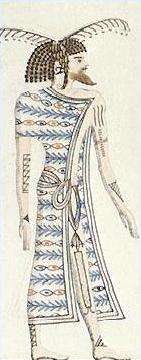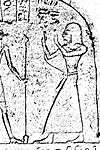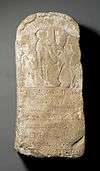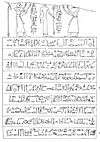Libu

The Libu (![]() , R'bw, Ribou, Labu) were an ancient Libyan tribe of Berber origin,[1] from which the name Libya derives.
, R'bw, Ribou, Labu) were an ancient Libyan tribe of Berber origin,[1] from which the name Libya derives.
Early history
Their occupation of ancient Libya is first attested in ancient Egyptian texts from the New Kingdom, especially from the Ramesside Period. The earliest occurrence is in a Ramesses II inscription.[2] There were no vowels in the Egyptian script. The name Libu is written as LBW or RBW in Egyptian hieroglyphs. In the Great Karnak Inscription Merneptah describes how hostilities between Egypt and Libya broke out and how the Libyans were defeated.[3] Ramesses III defeated the Libyans in the 5th year of his reign, but six years later the Libyans joined the Meshwesh and invaded the western Delta and were defeated again.[4] Libu appears as an ethnic name on the Merneptah Stele, also known as the Israel Stele.[5]
This name Libu was taken over by the Greeks of Cyrenaica, who co-existed with them.[6] Geographically, the name of this tribe was adopted by the Greeks for "Cyrenaica" as well as for northwestern Africa in general.[7]
In the neo-Punic inscriptions, Libu was written as Lby for the masculine noun, and Lbt for the feminine noun of Libyan. The name supposedly was used as an ethnic name in those inscriptions.[8]
Great Chiefs of the Libu
In the Western Nile Delta, some time during the 22nd Dynasty of Egypt flourished a realm of the Libu led by "Great Chiefs of the Libu". Those rulers soon formed a dynasty, and they often had local "Chiefs of the Ma(shuash)" as their subordinates. The dynasty culminated with the chiefdom of Tefnakht, who was both a "Great Chief of the Libu" and a "Chief of the Ma" at Sais, and later claimed for himself the pharaonic titles founding the 24th Dynasty.[9]
Here follows the succession of the known "Great Chiefs of the Libu". They used to date their monuments following the regnal years of the contemporary pharaoh of the 22nd Dynasty.[10]
| Name | Image | Attested in regnal year... | Corresponding absolute datation |
|---|---|---|---|
| Niumateped A | Year 10 of Shoshenq I or Shoshenq III | 936 or 816 BCE | |
| Inamunnifnebu |  |
Year 31 of Shoshenq III | 795 BCE |
| one or two(?) unattested chiefs | - | - | - |
| Niumateped B |  |
Year 8 of Shoshenq V | 760 BCE |
| Titaru, son of Didi |  |
Year 15 or 17 of Shoshenq V | 753 or 751 BCE |
| Ker |  |
Year 19 of Shoshenq V | 749 BCE |
| Rudamun | Year 30 of Shoshenq V | 738 BCE | |
| Ankhhor | Year 37 of Shoshenq V Year ? of Shoshenq V |
731 BCE ? BCE | |
| Tefnakht | _det.jpg) |
Year 36 of Shoshenq V Year 38 of Shoshenq V |
732 BCE 730 BCE |
See also
References
- ↑ Temehu.com. "Libyan People & Ethnic Tribes". www.temehu.com. Retrieved 2016-07-18.
- ↑ Clark, Desmond J. (ed.) (1982) "Egypt and Libia" The Cambridge History of Africa: From the earliest times to c. 500 BC volume I, Cambridge University Press, Cambridge, England, p. 919, ISBN 0-521-22215-X
- ↑ Breasted, James H. (1906) Ancient Records of Egypt, Part Three, Chicago, §§572ff.
- ↑ J. H. Breasted, Ancient Records of Egypt, Part Four, Chicago 1906, §§83ff. Afterward, the name appeared repeatedly in other pharaonic records.
- ↑ [...] The vile chief of the Libu who fled under cover of night alone without a feather on his head, his feet unshod, his wives seized before his very eyes, the meal for his food taken away, and without water in the water-skin to keep him alive; the faces of his brothers are savage to kill him, his captains fighting one against the other, their camps burnt and made into ashes [...] After Gardiner, Alan Henderson (1964) Egypt of the Pharaohs: an introduction Oxford University Press, London, p. 273, ISBN 0-19-500267-9
- ↑ Fage, J. D. (ed.) (1978) "The Libyans" The Cambridge History of Africa: From c. 500 BC to AD 1050 volume II, Cambridge University Press, Cambridge, England, p. 141, ISBN 0-521-21592-7
- ↑ ."Libya". Online Etymology Dictionary. Retrieved 2016-11-24.
- ↑ Thomas C. Oden (2011). Early Libyan Christianity: Uncovering a North African Tradition. InterVarsity Press. p. 51. ISBN 0830869549.
- ↑ Kitchen, Kenneth A. (1996). The Third Intermediate Period in Egypt (1100–650 BC). Warminster: Aris & Phillips Limited. ISBN 0-85668-298-5., § 249; 306
- ↑ Berlandini, Jocelyne (1978). "Une stèle de donation du dynaste libyen Roudamon". BIFAO. 78: 162.